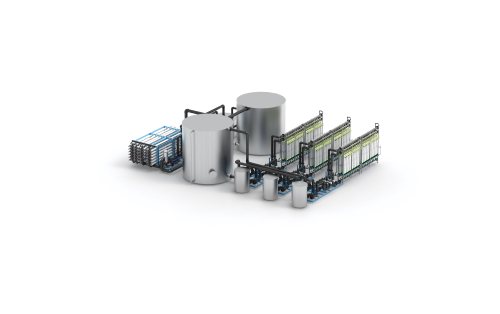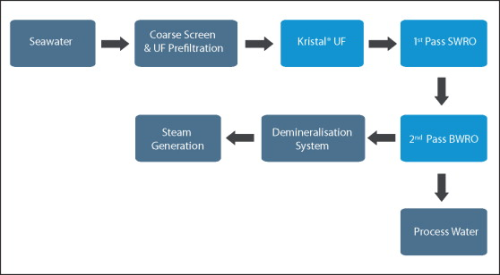


Hyflux says that its Standard Membrane Systems address the challenges of water shortages and water usage restrictions faced by industries and communities worldwide by providing a reliable, high quality supply of water in a simple, fast and cost-effective way. They are available in a wide range of sizes to suit various water treatment needs. According to the company, the Standard Membrane Systems are backed by Hyflux’s years of expertise and experience in design, development, process engineering, installation, operation and maintenance of small to large desalination facilities worldwide. In addition, Hyflux's Kristal® ultrafiltration membranes which are used in over 40% of seawater reverse osmosis (SWRO) desalination pre-treatment projects worldwide including large-scale desalination plants in Tianjin, China and Magtaa, Algeria, have a proven track record of performance in desalination and water recycling. Hyflux adds that the Standard Membrane Systems offer ultrafiltration water polishing, seawater and brackish water desalination solutions in capacities ranging from 0.12 MLD to 9 MLD. Designed for high performance efficiency and low lifecycle costs, Hyflux adds that the systems’ benefits include: • A standard design configuration for rapid turnaround time and fast delivery (with some models to be delivered within eight weeks). • Substantial cost savings passed on to buyers from Hyflux’s large-scale procurement of water treatment components. • High quality key components from leading international brands; all systems are integrated at Hyflux’s facilities in Singapore to maintain quality. • A modular, pre-engineered high-efficiency system for fast assembly with a small footprint. • Reliable operation – Hyflux’s experience and optimised, standard system designs ensure quick start-up and stable operations • User-friendly operation system and complete documentation support. With a standardised modular design, Hyflux adds that the Standard Membrane Systems range offers a total of 21 different models, ranging from 0.12 MLD to 9 MLD of different combinations of technologies, for rapid deployment and flexible capacity expansions. Each system has its own distinctive function. The UF-SWRO (seawater reverse osmosis)-BWRO (brackish water reverse osmosis) series produces industrial grade water with TDS less than 50mg/L, while the UF-SWRO series provides potable water with TDS less than 500mg/L. Separately, the UF-BWRO series produces high quality water from brackish water sources with TDS less than 100mg/L. The following case studies relate to smaller-scale desalination systems for industrial users.
Case study 1: Zhejiang, China
With Zhejiang ranking as one of the top provinces in China in terms of economic growth, much of the energy required to feed its booming industries comes from coal-fired thermal power plants that rely on seawater desalination technology to provide clean water for their boilers. One such power plant, located in the town of Wushashan, requires treated boiler feed water of up to 22,200 m³/day. A desalination plant is required for desalting water from East China Sea. As boiler feed water has to have a high level of purity, various salts, silica and suspended particles in the seawater need to be removed. Based on the raw water parameters listed in Table 1, Hyflux has designed a two-pass reverse osmosis system for this application, where 1,820 SWRO elements are used in the first pass, and 324 BWRO elements in the second pass. This is to ensure that the permeate quality meets the strict demands for boiler feed water. Hyflux’s proprietary Kristal® UF membrane has been selected as pre-treatment for the reverse osmosis -672 Kristal® modules are used, and the membranes provide good, consistent pre-treatment by removing suspended solids, organics as well as microorganisms.
Case study 2: Kalimantan, Indonesia
A fertiliser factory located in the city of Bontang in East Kalimantan requires up to 7,200 m³/day of clean water to manufacture ammonia and urea. The factory needs a system capable of performing with long mean time between failures (MTBF) and supplying high quality water to generate steam for the manufacturing process. Given its close proximity to the sea, seawater desalination is a feasible option for a sustainable source of water. Hyflux was selected to design, install and commission the plant, which includes a two-pass RO system preceded by Hyflux’s Kristal® UF membrane system to ensure a constant supply of consistently high quality feed water. The process flow of the plant is described in Figure 2. A total of 400 Kristal® membranes, 784 SWRO elements and 252 BWRO elements are used for the system. The product water from the desalination plant will go through a demineralisation system before being used to generate steam for the manufacturing process.
| Parameters | Unit | Value |
| Total suspended solids (TSS) | mg/L | 96 |
| Turbidity | NTU | 26 |
| Total dissolved solids (TDS) | mg/L | 26,397 |
| Silica, SiO2 | mg/L | 2 |
| Calcium, Ca2+ | mg/L | 435 |
| Magnesium, Mg2+ | mg/L | 1,099 |
| Sodium, Na+ | mg/L | 8,598 |
| Sulphate, SO42– | mg/L | 2,203 |
| Chloride, Cl– | mg/L | 15,679 |
| Total organic carbon (TOC) | mg/L | 0.46 |
| Oil & grease | mg/L | 0.18 |





